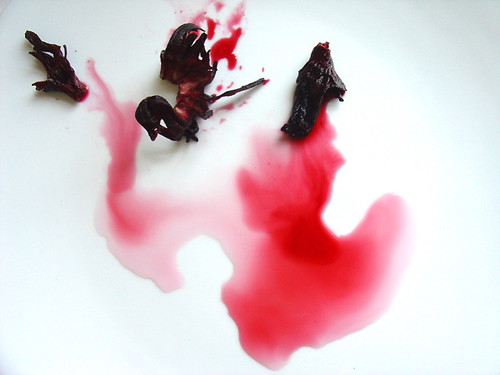Hibiscus Tea Lowers Blood Pressure
Hibiscus tea (sometimes called sour tea) is a herbal drink made from the calyces of the Hibiscus sabdariffa flower. It is also commonly mixed with other ingredients such as ginger and sugar to make a chilled beverage known as agua de jamaica or rosa de jamaica.
Hibiscus tea is believed to reduce blood pressure and cholesterol. While there are no studies looking at the effect of hibiscus on cholesterol levels, I did find two studies that showed positive results in treating high blood pressure. In this post, we'll take a look at both papers.
Study methods
In the earlier study, men and women with moderate hypertension were randomly assigned to either an experimental or a control group (link). Inclusion criteria were a systolic pressure of 160-180 mmHg and/or a diastolic pressure of 100-114 mmHg. Mean age in both groups was slightly over 50 years.
The experimental group was given a box of hibiscus tea, while the control group was given ordinary tea (black tea, I assume, though the authors don't say). The participants were instructed to use two spoonfuls of tea in one glass of boiled water at least one hour before measuring blood pressure.
The newer study used sixty diabetic patients with mild hypertension (link). Participants were told to drink either hibiscus tea or black tea twice a day for one month. Blood pressure was measured on days 0, 15 and 30.
Results
After 12 days of drinking a cup of hibiscus tea, the experimental group in the first study showed a 11.2% decrease in systolic pressure and a 10.8% decrease in diastolic pressure, as compared to the first day. The control group showed a slight decrease in systolic pressure but not in diastolic pressure.

The above graph shows the systolic blood pressure of the experimental and control groups. Here is the graph showing changes in diastolic blood pressure:

As you can see, both systolic and diastolic blood pressure went down in those who drank hibiscus tea for 12 days and then increased from day 12 to day 15. This is because after the twelve days, the participants were told to stop drinking tea and measured their blood pressure again after three days.
After stopping tea drinking, there was almost no change in the control group, while the blood pressure of the hibiscus tea drinkers quickly catched up with the control group. Hence, blood pressure was significantly affected by hibiscus tea but only slightly by ordinary tea. Furthermore, the authors speculate that the lowered blood pressure in the control group may in fact have been a result of the health advice given at the beginning of the study.
In the study with diabetic patients, systolic blood pressure went from 134.4 to 112.7 mmHg in those who drank hibiscus tea twice daily for a month. In those who drank black tea instead, systolic blood pressure increased from 118.6 to 127.3 mmHg. No statistically significant changes were seen in diastolic blood pressure in either group.
Mean pulse pressure, which is the difference between systolic and diastolic blood pressure, decreased in the hibiscus drinkers from 52.2 to 34.5 mmHg, while it increased in the black tea drinkers from 41.9 to 47.3 mmHg.
Conclusion
Hibiscus tea lowers blood pressure significantly in patients with mild to moderate hypertension. In one study, both systolic and diastolic pressure were lowered as a result of drinking hibiscus tea, while in another one only systolic pressure decreased.
In diabetic patients with mild hypertension, systolic pressure increased after drinking black tea daily, while diastolic pressure remained the same. In non-diabetic patients with moderate hypertension, both systolic and diastolic blood pressure decreased slightly after drinking black tea.
For more information on tea and blood pressure, see these posts:
Intermittent Fasting with a Condensed Eating Window – Part II: Blood Pressure, Body Weight & Cholesterol
A High-Protein Diet Is Better than a High-Carbohydrate Diet for Weight Loss
Green Tea Extract Increases Insulin Sensitivity & Fat Burning during Exercise
Drinking 10 Cups of Green Tea Daily and Not Smoking Could Add 12 Years to Your Life









1 kommenttia:
Have you looked up other studies about hibiscus tea? There is some stuff about hibiscus inhibiting LDL oxidation, and from what I gather there are anthocyanins in hibiscus too (and I believe we like those guys?)
http://www.ncbi.nlm.nih.gov/sites/entrez?db=pubmed&cmd=DetailsSearch&term=Hibiscus+sabdariffa&log$=activity
Post a Comment